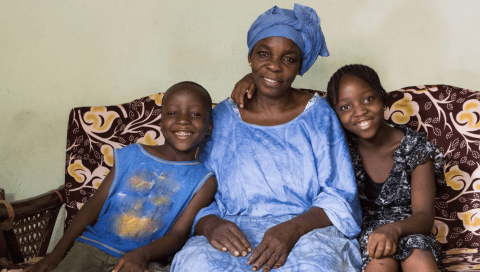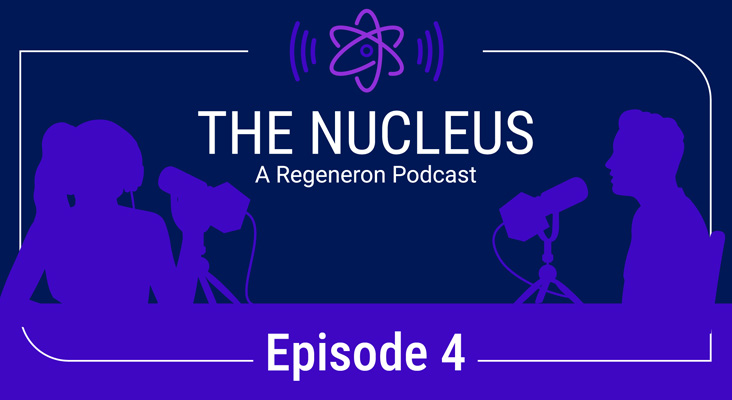Clinical Research & Medicines
Making A Drug You Hope No One Will Ever Need
October 31, 2018
A 30 year journey with a relentless focus on science
By: Neil Stahl, PhD, Executive Vice President, Research and Development

At Regeneron, over the last twenty-five years I’ve been involved in the discovery and development of new medicines that have helped a few hundred people and medicines that have helped millions of people. Working on our infectious disease efforts, however, I was involved for the first time in making a new drug that I hoped no one would ever need.
The story of REGN-EB3
The story of REGN-EB3 (also known as REGN3470-3471-3479), our investigational “cocktail” of three therapeutic antibodies to treat Ebola, goes back to the 2014 Ebola outbreak, which killed more than 11,300 people. By leveraging the power of our VelociGene®, VelocImmune® and VelociMab® antibody discovery and production technologies and through the support of the U.S. government’s Biomedical Advanced Research and Development Authority (BARDA), we were able to develop and validate this new therapeutic candidate in just six months. This cleared the way for additional preclinical research in animal models and a Phase 1 trial in healthy humans the following year. Led by my colleague Christos Kyratsous, this involved the seamless collaboration of many, many distinct teams across our company, with me simply asking questions and cheerleading alongside.
A Collaborative Approach: Regeneron Teams Involved In Our Efforts
- Infectious Disease Therapeutic Focus Area
- Preclinical Development
- Therapeutic Proteins
- Drug Safety & Pharmacometrics
- Protein Expression Sciences
- Planning, Strategy & Operations
- Preclinical Manufacturing & Process
- Regulatory
- Development
- Clinical
- Industrial Operations & Product Supply (IOPS)
In 2018, it took us 21 days working with the U.S. Food and Drug Administration (FDA) and World Health Organization (WHO) to prepare and ship EB3 to the Democratic Republic of Congo (DRC) after the May 10th Ebola outbreak began. Twenty-one days: less time than it takes food to go bad in your fridge; less time than most people take annually for vacation—but still a long time in context of a devastating outbreak such as this one.
Luckily, that particular outbreak ended relatively quickly, perhaps because of the “ring vaccination” strategy using an experimental vaccine and lots of coordination from groups on the ground. However, now in October 2018, we are in the midst of a second and more prolonged outbreak in a different and more remote area of the DRC.
EB3 is administered in a single dose, and its stability means it does not have to be stored in a deep freeze, a helpful attribute when drugs have to be shipped by riverboat, on unpaved roads, or by helicopter in a brutally hot climate. The triple-antibody approach is designed to target the Ebola virus at multiple points since the virus is known to mutate in different outbreaks. Each antibody binds to different sites on the virus, which increases the overall cocktail‘s chance of blocking a mutated Ebola virus.
“The triple-antibody approach is designed to target the Ebola virus at multiple points since the virus is known to mutate in different outbreaks.”
EB3 is part of the WHO’s ethical framework known as Monitored Emergency Use of Unregistered and Investigational Interventions (MEURI), which establishes certain criteria for access to investigational therapeutics outside of clinical trials. Our Ebola team secured various regulatory approvals, country approvals, and import licenses to deliver EB3 to providers on the ground in Kinshasa and then transport it to the location of the more recent outbreak. Again, this was a masterclass in internal teamwork and collaboration with outside organizations: our colleague Sumathi Sivapalasingam was emailing with WHO at four in the morning and getting regular, critical updates by phone. Leah Lipsich was similarly in close contact with our partners at BARDA, ensuring everyone was in the loop and pushing towards the same goal.
Until recently, it was unclear if EB3 would be used during this particular outbreak; the patient and medical community is lucky that over the past few years, there have been numerous developments in the Ebola field and that there are now several vaccines and five investigational therapeutics available. It’s up to the doctors and nurses on the front lines to determine which available treatment is most appropriate or most convenient for each patient.
We heard in late September that EB3 had been administered to five patients in the DRC (now up to 28 patients dosed in late October). We’re proud to have expanded the medical options for this devastating disease, and we hope that our treatment will safely and efficaciously impact the course of the disease. We’ll also be tremendously relieved if these people are the only patients that receive our treatment, because the outbreak is soon declared over. In any case, the dedication of our team and research efforts will surely be worth it if we can help even one person.
Making a difference
Our work is inspired by the example set by our Chairman Dr. Roy Vagelos, who was the Chief Executive Officer of Merck during the ‘90s. He set an industry standard for corporate social responsibility while at Merck: free of cost, the company developed and delivered a drug that effectively cured African River Blindness. This eventually helped 55 million people across two decades. Regeneron is inspired by a similar goal: to use the power of our science to bring new medicines to patients in need. If we do that, our business does well. But many times, such as during an Ebola outbreak, profits, and commercial potential are the furthest things from our minds.
In addition to Ebola, we’ve applied our technologies and scientific expertise in other infectious diseases such as Zika, Middle Eastern Respiratory Syndrome, and influenza, not for the potential of any commercial profit, but because it is the right thing to do. We expect to continue adapting quickly as new infectious diseases emerge and producing new options for patient in need—again working closely alongside BARDA and other leading health agencies. Motivated by this commitment and armed with the speed and precision of our technologies, we strive every day to make a measurable difference in people’s lives. And in the case of Ebola, we’ll be watching developments in this outbreak with our fingers crossed and our hearts with the people of the DRC and the selfless medical personnel who are caring for them.
The use of EB3 in Ebola is investigational and has not been evaluated by any regulatory agency.
More Regeneron Stories


